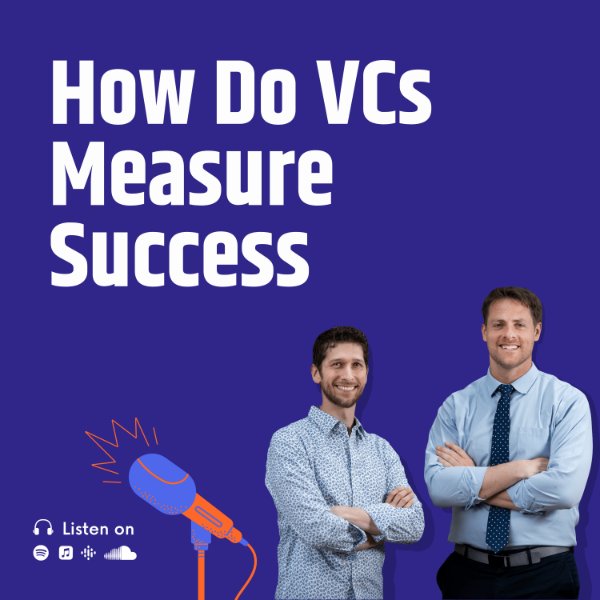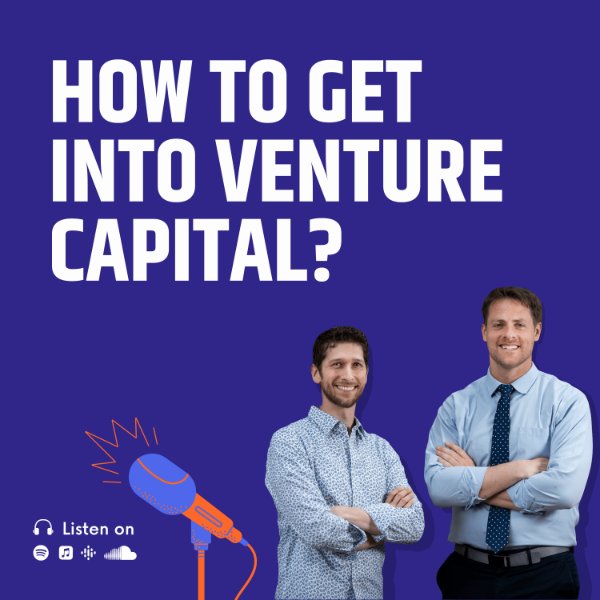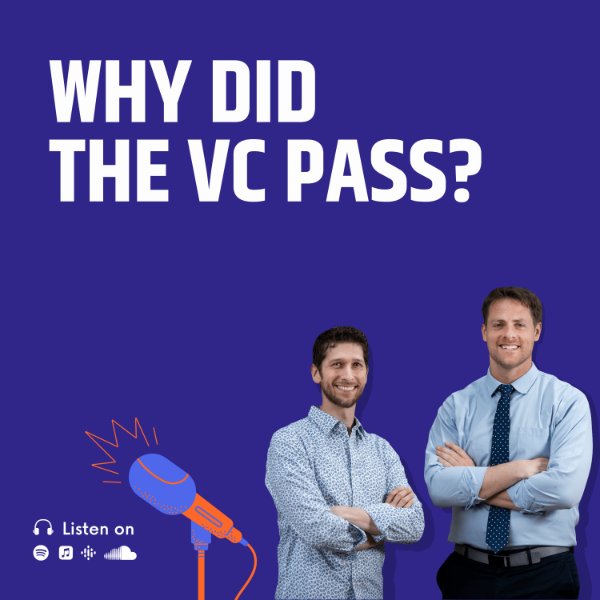Peter:
Jon: But in your last valuation was like say 90 million and you're trying to raise at 100 million, that's a fairly large gap to catch up with at some point. At some point it's going to.
Peter: I mean growing from like 80 to 100 million is not a big deal, right? I mean, companies in terms of valuation, but like the bigger issue is like, let's say you're worth in today's market, like, I don't know, 100 million, but last round was like 200 million. Right. Then the argument is like, hey, give us enough money that we can actually grow into that $200 million valuation by us.
Peter: Enough run, you know, buys enough runway that we can get there. And, you know, look, if you if you grow revenues and you perform, you can get to those higher valuations. They just take time and money. Right.
Jon: Have you participated in one of these deals where you're offering warrants as part of the round?
Peter: do you think about that? Not yet.
Jon: Financially, but we've.
Peter: Looked at several. Yeah.
Jon: Whether it was the genesis of this idea coming from.
Peter: I don't know that it's like an old idea per se, you know. Warren coverage has always been around. I mean, one of the best deals we did.
Jon: Innoventures did a lot with warrants.
Peter: Yeah, yeah. Innoventures that because they were, they were.
Peter: Right and they would use warrant coverage as a, as a kicker for equity. Silicon Valley Bank does a lot of that. There's a lot of venture debt funds that do that. So yeah, warrants aren't anything new. I think I think a lot of it is just like, hey, these entrepreneurs are saying, hey, we really don't want to take it down round because there's all these negative things that go with it.
Peter: Can we come up with a structure that works? And, and investors are like, I need to get my cost basis down lower, right, in order for this investment to make sense. And so if you throw in some warrant coverage, we'll give you the valuation you want. And then, you know, if we decide to exercise our warrants in the future at some future date because you're performing well, then you know, that's a win for everybody and you just take some more dilution, but it's not a big deal.
Peter: We did a deal like this in the prior in our first fund in a company that, you know, is in an industry that was unloved at the time and, and they were giving 100% warrant coverage, which at it wasn't a penny. Warren It was just normal warrant coverage. So, you know, you know, we bought, you know, you buy $1,000,000 worth of stock in the company and then at some future date, you could buy another million at that same price that you'd paid several years before, and that that ended up performing really, really well for us again, because it was, you know, to the extent that value investing actually exists.
Peter: And we see it was like one of those opportunities to say like, hey, this is an undervalued asset. And then they're given some structure and some incentives and, and but the rest of the business is doing really well. It's just like this broader macro environment that's that's working against them. And so that's why I made the bet and ended up paying off.
Peter: But I would say more often than not, anytime you're adding like tons of structure, it's kind of a red flag that the companies in. They're not a great spot.
Jon: So is this a short term play or a long term play, or do you think this this fad will disappear in 1 to 5 years now?
Peter: I think it I think it'll disappear. I think this is a singular moment in time.
Jon: Why not just not have warrants and just say, hey, this is the market and.
Peter: Because you're taking a down around, right? And then that comes with all those negative things I talked about earlier.
Jon: Someone has to go hit somewhere.
Peter: So yeah, but, you know, is there a way to do it to save face? I mean, that's ultimately what they're doing, right? They're taking the down round from a dilution perspective. Just not from a pure valuation perspective.
Peter: I don't know. This is I just think it's super interesting because.
Jon: If you were fundraising right now, would you which option would you go would you go for down around or would you do have some sort of structured warrant as part of the the deal?
Peter: And I yeah, that's a good question. I think I would probably take the warrants structure because I think you ultimately get to the same place, but you're able to tell a better story internally.
Jon: Are there any other mechanisms besides warrant coverage that are popping up right now?
Peter: MARKET The other thing that you're starting to see more and more is bonds and liquidation preference.
Peter: So liquidation preference is when the company gets acquired and it gets acquired for less money than the last round.
Jon: So let's give you an example, because they don't know what a liquidation preferences. They've got a company that sells for 10 million and I raised a million and investors took 10%. Yeah, the liquidation preference means if it's a1x liquidation preference, it means that investors that put in a million get a million out, there's 9 million left and then they have their 10%.
Jon: They take 10% of their 9 million. Let's say they have a3x liquidation preference, which would be considered high. And in that case in the same deal they would take the first 3 million off the table, there would be 7 million left. Then they would take 10% of that 7 million.
Peter: So that that's correct for what's called participating preferred or.
Peter: Yeah. Participating preferred liquidation preference wherein the investor doesn't have to choose between converting into common or staying preferred in order to get their ownership percentage. that's not that kind of has fallen out of favor. You're still seeing that occasionally pop up. Mostly what's common is non participating in preferred wherein the investor has to choose between getting their ownership percentage or getting their money back.
Peter: And that's the more kind of entrepreneur favorite favorable term. So in your example, the company sells for 10 million bucks, you own 10%. So you're going to get a million either way, right? What's more interesting is the company sells for $5 million. Your 10% would be worth five K, but because you have this one X liquidation preference, you get $1,000,000 back and that leaves $4 million for the entrepreneurs just.
Jon: In your non participating.
Peter: From participating. And then the flip side is the company sells for $20 million and you now have this choice of do I get my million dollars back or do I convert to common? And I take my ownership percentage, which would be 10% and 2 million bucks. I mean, that's obvious, right? You're going to take you're going to convert and take the 2 million.
Peter: But what we're seeing is there's a slight increase in participating preferred, right.
Peter: Your get your cake and eat it, too, as I like to call it preference because you get your money back and you get your ownership percentage. and you're also starting to see a bump up from just kind of one x 2 to 3 so forth. And really it's investors saying, hey, look, you know, maybe we'll give you a valuation that's a little bit high, but we really want to protect our downside.
Peter: Yeah. And so if things don't pan out and things, you know.
Jon: So you're saying in Nonparticipating liquidation preferences, they're taking 2 to 3 X multiple.
Peter: In some cases. Yeah.
Jon: What it was industry standard, maybe not like the last year when everything was bloated, but like kind of, you know, the average for last five years.
Peter: I mean average for the last five years, you know, we've been I mean, really for the last ten years we've been on this like ever increasing entrepreneur friendly terms trend. And so, you know, a quote unquote clean entrepreneur friendly term sheet was one X non non participating preferred. Yeah liquidation preference.
Jon: And right now you're seeing 2 to 3 X number.
Peter: Some cases I would say across the board.
Jon: Okay. Some cases like 10% or less or what are these are just companies that are going to have down round so they're trying to figure out how to protect.
Peter: Yeah. Downtown's fly arounds. Yeah.
Jon: But if you're not having a down around you're not seeing these at all.
Peter: Probably not. I think a lot of the I mean what's tricky is, you know, you're looking at companies that are getting funded internally by insiders. And so, you know, you're not always seeing what those terms are. In some cases, they're just doing convertible notes or safes to basically kick the can down the road, give them some more runway and hope that they grow into a valuation that's equal or above the last round.
Jon: Are you seeing more bridge loans?
Peter: Yeah, for sure. A lot more safes and bridges. Yeah, but those are tough. I mean you still have a lot of have to have a lot of conviction because nobody wants to be invested in a bridge to nowhere. So. All right. I don't know. Viewer and entrepreneur, what would you take? Would you take the warrants? Would you take a lot of structure?
Peter: Would you. I think every lay off most of your employees and try to get to profitability. What would you do.
Jon: Assuming you could raise I'm assuming that most people would want to have a continued positive round number.
Jon: And that way would set a tone with the employees. You can still look awesome when you get featured in TechCrunch. Yeah, so that's probably where I would go, I think too. I think it's hard for people to take the poison pill or the hard dose of reality.
Peter: Yeah, but do you think they should.
Jon: In the perfect world by would.
Jon: I don't think we live in the perfect world. And if I was raising and I was in that scenario, I'd probably try to kick the can or not have some down out.
Peter: Yeah. I'll tell you, the one thing that I think is interesting is a lot of the VCs I know have a lot of free time on their hands these days because they're like, they're kind of sitting on their hands right there. They're like, you know, I'm not really deploying any any capital in these markets because I don't know where valuations are going to end up and things are risky.
Peter: And probably the biggest issues I need to conserve cash for my my current portfolio in case they need more money, right? and so that all of those things, like, you know, gets them to pull back on new investments, resulting in especially on a comparative basis to last year where like VCs were working overtime to get deals done, not doing quite as much, which has been kind of an interesting thing to watch, especially this summer.
Peter: I mean, there's so many people going on vacation and, you know.
Jon: I saw my mother today and I thought it was hilarious. How do you spend their day?
Peter: Yeah, And what did it say?
Jon: I was trying to find it on Twitter. I can't find it all fast, but it's basically it's like watching the on podcast for the first 90 minutes, take kids to school. They have one meeting schedule, lunch break.
Peter: Cents and like five emails.
Jon: You know, self-reflection period. It's 530 on personal time.
Peter: So send three emails to tell their their portfolio companies to just hang on there. Hang in there.
Jon: Yeah, I don't know. But yeah, I'd be a tricky time deploying capital.
Peter: Yeah, but you know, look, I think a lot of them are going to be back to market because so many funds raised so much money last year. There has not been deployed. So and then that money's got a clock ticking on it. Right. They can hold off for probably about a year before they got to really kind of buckle down and start deploying.
Jon: Are they waiting for around for price rates to drop even more?
Peter: I think, yeah, that's a good question. I think really what they're looking for is stability.
Jon: Yeah, when instability happened in venture capital, then.
Peter: When does it happen? I mean, I think when you when the IPO market reopens, you probably have some stability.
Jon: When does Peter think that will be?
Peter: Who? I don't know. I could see companies start to go out, probably not in, like, a super meaningful way, but. But, you know, kind of start some time next year.
Jon: Okay? So like, say, like.
Peter: Like 12 months from now.
Jon: 12 months, like it's going to get like six months. So you're saying 12 months?
Peter: Yeah, I think. Trevor, I feel like we got another shoe to drop here.
Jon: Look at. Possibly. Possibly.
Peter: Yeah. I mean, there's so many things going on in the geo political environment that, you know.
Jon: We'll see when we have again. And we've got elections coming up and who knows what happen with stability that.
Jon: All right. Well, thanks for watching, guys. This was the venture capital podcast. Go to WW dot venture capital dot app M and make sure you subscribe to this channel. Leave comments below. We'd love to be able to answer your questions. Thanks, guys.







